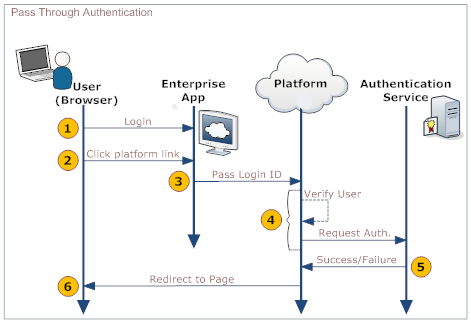Pass Through Authentication
Pass Through Authentication (PTA) lets a user go straight to the platform from an organization's web page or application, without having to log in again.
How it Works
While using an enterprise application, a user would like to visit a page hosted on the platform, without having to log in to the platform to see it (after having already logged in to the enterprise app). To accomplish that goal, the application sends a small SOAP message to the platform, in an HTTP request. That message contains the information needed to log into the platform. Data in it is passed to an authentication server, which sends back a message saying that authentication has succeeded or failed, after which the user is directed to the appropriate page, as shown in the following diagram:
Here is an explanation of the steps:
User Your Organization's Web App Platform Authentication Server 1. Logs in to a web page or application provided by your organization 2. Clicks a link that goes to a platform page 3. Passes data to the platform's PTA service in the SOAP payload - Session ID (optional, but desirable)
- Login ID
4. - Receives data in the SOAP payload:
- Passes data to the Authentication server
5. - Authenticates the user
- Sends back a success- or failure-report
6. Redirects the user to the appropriate page.
Enabling Pass Through Authentication
The URL of the Authentication Server and the URLs of the pages to visit in the event of success or failure are configured in the platform's Single Sign-On Settings:
- Go to
 > Administration > Company Setup > Single Sign-On
> Administration > Company Setup > Single Sign-On - Click the [Edit] button
- For Single Sign-On Settings, choose Pass Through Authentication
- Fill in the Pass Through Authentication Settings:
- Third party Authentication Service URL
- Location of the authentication service. The platform uses this URL to authenticate the USER, passing the appropriate pay load in the HTTP request.
- Success page URL
- The page the platform sends the user to when authentication succeeds:
- If not specified, the default destination is the platform's home page.
- Error page URL
- The page the platform sends the user to when authentication fails:
- If not specified, the default destination is the platform’s Login-error page.
- Can be overridden dynamically by the Authentication Server
- Click [Save]
Message Formats
Posting a Form to the Platform
The application or web page can use a form like the one shown below to do an HTTP POST to the platform. The user is then seamlessly redirected to the success or failure page, depending on the results of the authentication.
<form id='testForm' action='https://{domain}/networking/passThroughAuth' METHOD="POST" enctype="application/x-www-form-urlencoded" > <input type="hidden" name="loginID" value="jondoe@test.com"> <input type="hidden" name="sessionID" value="adasd3qw4q4weasdasd"> </form>
where:
- loginID
- The user's login name on the platform--typically in the form of an email address.
- sessionID
- The session ID of the user on the organization's website. Optional. It is passed on to the authentication service, so the authentication service can make use of it.
- Form data sent from the platform to the Authentication Server
- When the platform receives POSTed form data, it passes the data to the Authentication Service using content type application/x-www-form-urlencoded, in a request like the one shown below:
- Method
- POST
- URI
- Configured in the Single Sign-On Settings
- Content-Type
- application/x-www-form-urlencoded
- Payload
- A URL Encoded version of a data string that looks like this:
loginID=jondoe@test.com&sessionID=adasd3qw4q4weasdasd
- The Authentication Service reads the identification parameters from the request--as in this Java code, for example:
String loginId = (String)request.getParameter("loginID"); String sessionId = (String)request.getParameter("sessionID");
Sending a SOAP Request to the Platform
This message format can be delivered to the platform by an application or web page.
- Method
- POST
- URI
- https://{yourDomain}/networking/passThroughAuth
<?xml version="1.0" encoding="UTF-8" ?> <soapenv:Envelope xmlns:soapenv="http://schemas.xmlsoap.org/soap/envelope/"> <soapenv:Body> <LJAuthenticate xmlns="urn:authentication.soap.ws.longjump.com"> <sessionID>...</sessionID> <loginID>...</loginID> </LJAuthenticate> </soapenv:Body> </soapenv:Envelope>
where:
- sessionID
- The session ID of the user on the organization's website. Optional. It is passed on to the authentication service, so the authentication service can make use of it.
- loginID
- The user's login name on the platform--typically in the form of an email address.
- SOAP request sent from the platform to the Authentication Server
- When the platform receives a SOAP request, it sends a message in the following format to the Authentication Server:
- Method
- POST
- URI
- Configured in the Single Sign-On Settings
<?xml version="1.0" encoding="UTF-8" ?> <soapenv:Envelope xmlns:soapenv="http://schemas.xmlsoap.org/soap/envelope/"> <soapenv:Body> <LJAuthenticate xmlns="urn:authentication.soap.ws.longjump.com"> <sessionID>...</sessionID> <originatingDomain>...</originatingDomain> <originatingIp>...</originatingIp> <loginID>...</loginID> </LJAuthenticate> </soapenv:Body> </soapenv:Envelope>
- where:
- originatingDomain
- Name of the Domain the request originally came from (e.g. wwww.paaspartout.com)
- originatingIp
- IP Address of the domain the request originally came from (e.g. 10.20.30.40)
- sessionID
- Passed on from the original request
- loginID
- Passed on from the original request
Messages Returned by the Authentication Server
After authenticating the user, the server sends back a success or failure response.
- Authentication-Succeeded response
- This response is sent when authentication succeeds.
<?xml version="1.0" encoding="UTF-8" ?> <soapenv:Envelope xmlns:soapenv="http://schemas.xmlsoap.org/soap/envelope/"> <soapenv:Body> <LJAuthenticateResponse xmlns="urn:authentication.soap.ws.longjump.com"> <status>AUTHENTICATED</status> <loginID>userLogin@Login.com</loginID> </LJAuthenticateResponse> </soapenv:Body> </soapenv:Envelope>
- Authentication-Failed response
- This response is sent when authentication fails.
<?xml version="1.0" encoding="UTF-8" ?> <soapenv:Envelope xmlns:soapenv="http://schemas.xmlsoap.org/soap/envelope/"> <soapenv:Body> <LJAuthenticateResponse xmlns="urn:authentication.soap.ws.longjump.com"> <status>NOT_AUTHETICATED</status> <loginID>userLogin@Login.com</loginID> <redirectOnErrorURL>http://www.location.com/somePage</redirectOnErrorURL> </LJAuthenticateResponse> </soapenv:Body> </soapenv:Envelope>
- where:
- redirectOnErrorURL
- URL of the next page the user sees. (Overrides the Single Sign-On settings.)
